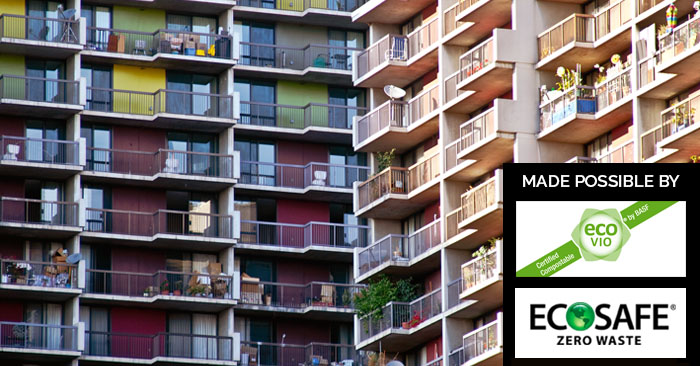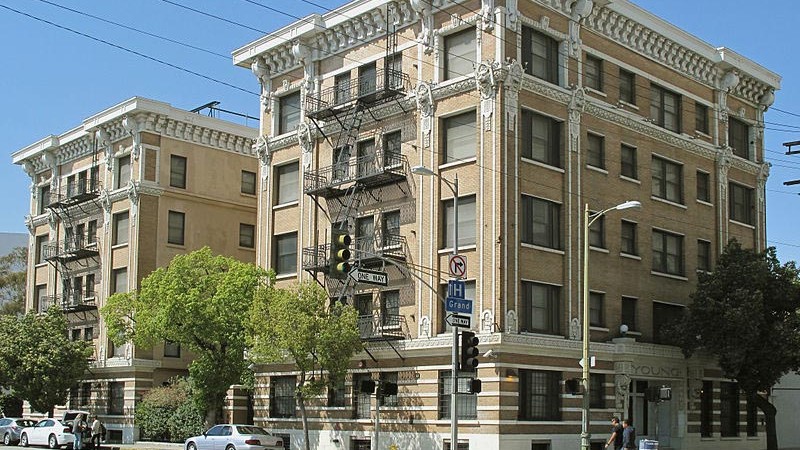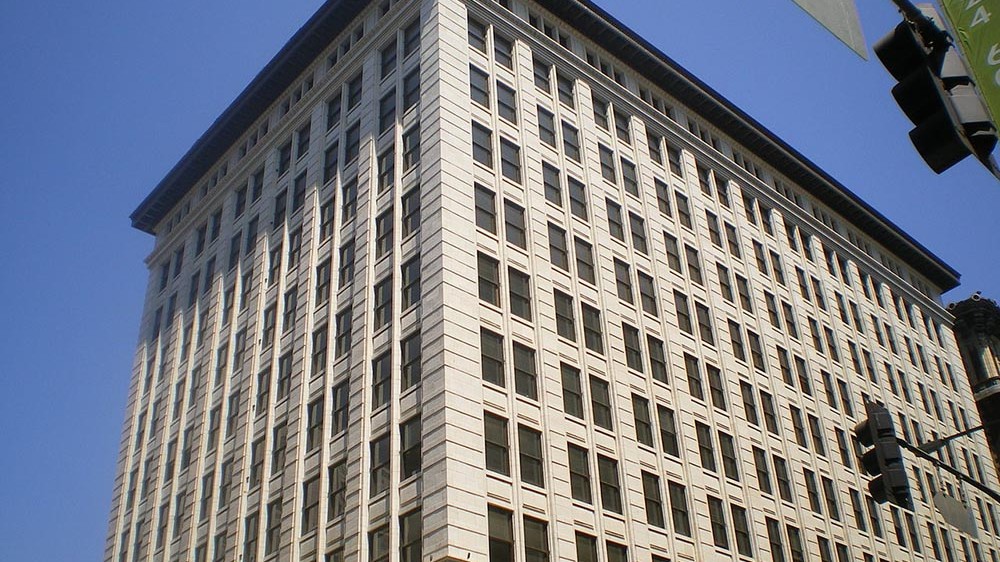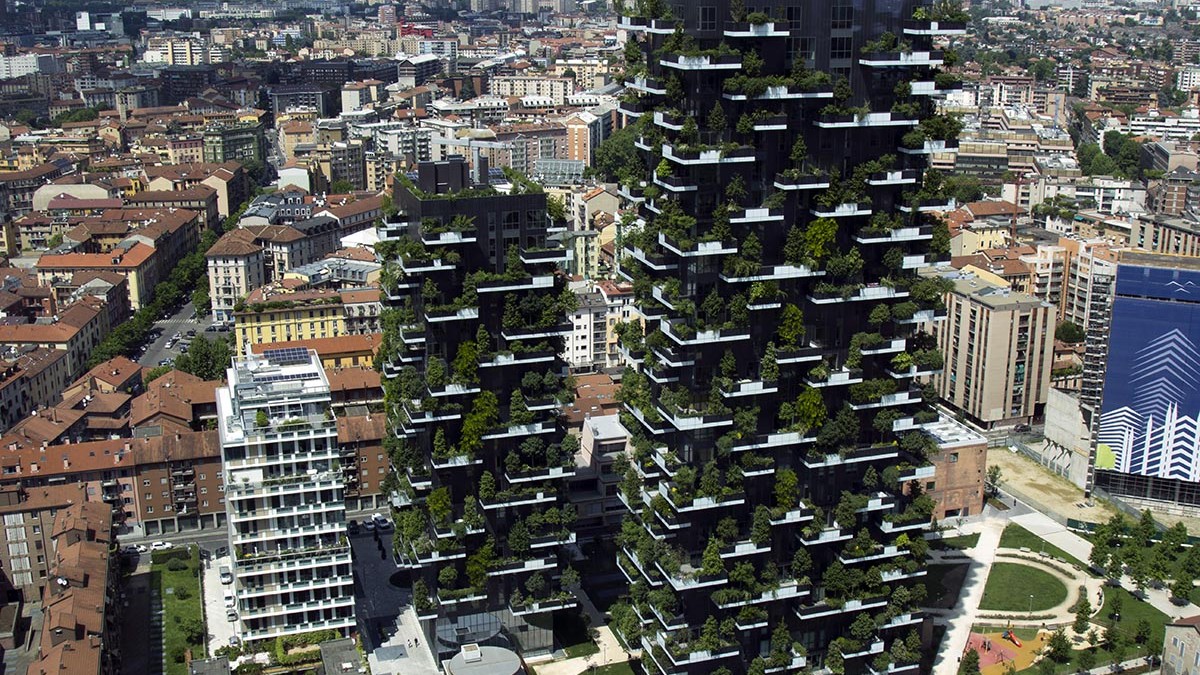INTRODUCTION
THE ORGANIC STREAM: On our journey through the planning stages of multi-residential organics programs, we’ve come across many challenges. Some easy to deal with, others still difficult to solve – like the problem with chutes in San Francisco.
It’s clear that just like buildings, no two cities are alike – each have their own history, culture, unique demographics and structure – And all of this will impact how an organics recycling system should be designed. But what connects all the cities we’ve talked to is their determination to succeed, their skill in navigating problems, and their drive to improve.
And as more and more cities like these start tackling food waste in their apartment buildings, we’re creating a whole library of experiences, best practices, and successful strategies to learn from.
In the final two episodes, we take a closer look the cities leading the way – and explore just what are the key strategies they use that makes them so successful.
Let’s jump right in!
CHAPTER 1: PILOTING AND PARTNERSHIPS – LOS ANGELES CASE STUDY
TOS: On this show, we’ve talked a lot about building relationships. With tenants, with building managers…and we’re going to kick-start this episode by exploring another essential relationship for any organics program to work: the relationship between the key partners.
Because without communication and collaboration between program coordinators, haulers and processors, outreach teams and building managers too, collecting and recycling organics would become an impossible task. It really takes a team effort to make it work.
And over the course of producing this show, there was one program that really stood out to us showed…us just how beneficial this team building is.
I’m taking us back to Los Angeles.
JESSICA ALDRIDGE: Hi, my name is Jessica Aldridge, I’m the sustainability manager for Athens Services, I’ve been there for three years.
JASON SANDERS: Hello, my name is Jason Sanders with EcoSafe Zero Waste.
TOS: Here we are, standing outside the Old Bank District multistory building with Jason Sanders and Jessica Aldridge as we get ready to take a tour and learn all about their pilot program.
JESSICA ALDRIDGE: And so I and my crew at Athens wanted to do something ahead of time to figure out how this was going to work. What things are going to work well, what road bumps are we going to come up against. We wanted to try to pick apartment complexes with varying demographics and situations with how their waste is collected, and set up different types of infrastructure to see what works best, and what type of outreach works best. Because what works here may not work for somewhere else. And so in 2017, when the franchise agreement comes into play in the city of Los Angeles, we will already have the experience and the resources available to us to say “now we know”, when I have ten apartment complexes coming to me wanting to do this, I and my crew, and the staff at Athens are not going to feel overwhelmed and say “I’ve never done this before”.
TOS: So Jessica gives us an insight into their thinking in starting up the program. From here, Jessica and her team started looking for the right partners to work with – and those partners were Global Green USA and EcoSafe ZeroWaste.
Together they make an effective team – Jason and Jessica work closely together, visiting the properties every month and address any issues together. And it is clear that all three partners share the same goal for the program.
JASON SANDERS: Well it’s just really important for all partners to have a good understanding of what’s working and what’s not before a mass roll-out. So we’ve really got to dial in the success factors and those factors that aren’t working, and be able to address those. And that’s really what this pilot program is doing right now.
JESSICA ALDRIDGE: We work with the apartment managers, we tell them exactly what’s going to be happening. And then from there you have to get the buy-in from the managers as well, that this is something that they want to take on, and knowing that this most likely be a long-term pilot until we can get the right feet underneath it. And we knew from the beginning – we never thought we were going to kick this thing off and it was going to be perfect from the beginning. I don’t want it to be perfect. Well, I want it to be perfect in the end, but I don’t want it to be perfect in the beginning, because if it is you learn very little to be able to move forward and create these types of programs more so down the road.
TOS: So the pilot acts as a learning experience for all partners – instead of looking for perfection, you’re looking for the challenges. This is how a program grows strong. And overcoming those challenges can only happen when all partners understand and share this same purpose.
When we sat down to chat in the café on the first floor of the Old Bank District Building, we took the time to ask about their partnership, and what they considered important when selecting partners and building a strong program.
JASON SANDERS: Three crucial partners are always needed: hauler and processer being one, building manager is number two, and then we have us as a partner that has the tools for the program. And if you have communication outreach partner as well that always comes in handy, and in this case Global Green was that partner. And those partnerships have to be valued from the very beginning of designing the program, to the program launch, to long-term viability of the program. So those partners are together through that entire process.
TOS: So for a program to work, all key partners need to stick together from the very beginning, and all through the process. If there is a lack of communication or a lack of support from any of these partners, the program will suffer. As we saw in LA, all three key partners of the pilot program can keep communication channels open, learn from each other’s experiences and build a strong foundation for the future when the program expands.
CHAPTER 2: SUCCESSFUL ROLL-OUT STRATEGIES – MILAN CASE STUDY
TOS: Milan – a city of 1.4 million people at the northern Lombardy region of Italy. Milan began roll-out of its city-wide organics recycling system in November 2012 and is currently the largest city in the world running a formal separate collection scheme for organic materials. It’s also the city with the highest capture rates in Europe: with an average of 95 kg, or just over 200 pounds, of food waste being collected per inhabitant a year.
On top of this, almost 90 percent of the population in Milan lives in multistory residences – and still the contamination rate stays below 5 percent.
So how does the system operate?
In multistory buildings, it’s quite standardised: tenants collect their food scraps in kitchen caddies, and bring these down to the common waste room to throw into wheelie bins. Even tenants living in very high buildings, like skyscrapers, are expected to bring their scraps to the waste rooms on the ground floor – since there are no chutes in the city.
Then, the bins are brought to the curb on certain days for pickup. It’s important to note here that Milan operates a kerbside collection scheme, or door-to-door collection scheme. This is the system used in all the cities we’ve talked to – and for good reason.
By collecting from each household or building, haulers and program coordinators can track who is participating and who isn’t. They can more easily reward those who are doing it right, and can target those who are doing it wrong. In Milan, this means a fine for contamination – and for multistory buildings, the fine is shared among tenants – giving them a reason to recycle properly. And, by performing well, neighbourhoods can also compete for prize money for local schools – as a sort of reward.
Let’s compare this with the more traditional bring system – where people put their organics in a roadside container or fixed spot outside their building. There is no control over how well sorted the materials are. Because it’s impossible to know who puts what inside, it means people can contaminate the stream without fear of consequences. For example, the bring system for organics in Barcelona, Spain, experiences a contamination rate between 15 to 30 percent – much higher than Milan. Because of this anonymity, cities lose the ability to target offenders, and also to reward those who do well.
So while kerbside collection systems are relatively new to cities, they are proving to be a great way to ensure success for organics recycling programs.
And this is the case in Milan. The scheme is also known for being quite popular with residents, and this popularity is the result of a very smooth and well-coordinated roll-out strategy.
But how did a city with so many multistory residential buildings manage to roll-out so smoothly?
ENZO FAVOINO: We did a customer satisfaction analysis last year, and we came up with very intriguing results…
TOS: This is Enzo Faviono – researcher and advisor at the Scuola Agraria del Parco di Monza in Italy, coordinator of the Working Group on Composting and Sustainable Waste Management.
EF: Seventy nine percent of the population declared support of the system, with a critical area of those showing to be unhappy only totalling seven percent of the population.
TOS: Enzo and his team played an instrumental role in helping the city of Milan implement their organics recycling scheme. During our call in the summer, I asked Enzo to tell us all about their strategy, and the critical factors for their success…
EF: So we did a couple of campaigns in order to test the contamination rate, and the outcomes were very, very satisfactory because we found more than ninety five percent purity of collected food waste, which puts Milan in line with the outcomes of the border municipalities. So, it’s not a matter of a densely populated area relative to a small village; it’s a matter for the type of the scheme.
TOS: I wanted to start with this clip, because it straightaway hones-in on the key element for success. Milan is a big and very dense city. But even with these challenges and with so many high rises, Milan was able to match the border municipalities’ low contamination rates and keep the system running smoothly.
Enzo is saying that size does not matter, but the type of scheme does. So what type of scheme do we need to be successful?
EF: If it generates comfortability for the people they will participate, and they will adopt the proper care for the system to be run. We tend to believe that we can’t ask people to provide excess effort. We don’t want it to be made painful for them to participate in separate collection, so it has to be made as user friendly as possible.
TOS: This brings us back to that old mantra: Convenience is king. So what was it that Milan did to make their scheme as convenient as possible for residents?
EF: First of all, let me mention that Milan was divided into four quarters, each of which totalled a population of three hundred and fifty thousand people. So the scheme was implemented by steps. The first step covering the first quarter of three hundred and fifty thousand people in November 2012, then the second in June 2013, the third quarter in December 2013, and the fourth in June 2014. So in slightly more than one and a half years we could cover one hundred percent of the population.
Whenever we implemented the system in a new area, we gave a starter kit to the households which included the kitchen caddies, to have a good, clean management of the organics in the kitchen, and a starting role of fifty biobags. Fifty biobags may cover the needs for half a year. In Milan we have two collection rounds per week, so we would normally need one hundred bags a year per household. But we gave them only fifty for the first six months, because now the system in Italy is fundamentally supported by the fact that Italy was the first country in Europe to adopt a full ban on polyethylene shopping bags. So now in all the supermarkets you can get a shopping bag that is biodegradable, so you can use it once as a shopping bag, and a second time as a lining for the kitchen caddie during the collection of biowaste.
TOS: Enzo gives us a few points here to think about. The polyethylene shopping bag ban in Milan increased the level of convenience for tenants, Enzo tells us. We know from episode two the problems that New York are facing – when people can’t afford or find biobags, they can end up using polyethylene plastic bags instead.
Another point of interest is the delivery of biobags and kitchen caddies before roll-out. This is very convenient for tenants first of all, but both biobags and kitchen caddies are also great tools to tackle the infamous “yuck” factor – which can often make people squeamish about an organics program. Using these tools, Enzo reported that the “yuck” factor was not much of an issue for residents.
EF: Yuck was not a main issue for disappointment. That’s basically because the use of the biobags is incredibly helpful in this respect. We also used vented kitchen caddies, because by using the transferability of the biobags and the vents in the kitchen caddies, we tend to lose up to twenty percent of the whole weight of food waste in terms of water vapour. So we tend to have only small amounts, if any, of leakage at the bottom of the biobags. But in any case, it’s fully kept by the biobags, so this keeps the system tidy.
TOS: Now, we can’t finish talking about convenience factors in Milan without mentioning one of the biggest contributors. The closing of chutes by the city. In episode one we dived into the problem with chutes, and how they impact programs like San Francisco’s and New York’s…
EF: We used to have the chutes in the past. Of course the chutes would kill any effort on separate collection, because the take responsibility away from the households, unfortunately. Now, no new building may have any chutes, and they were fully closed in the old buildings.
TOS: Enzo’s words really drive-home how big an impact chutes can have – it can kill an organics collection program. Inadvertently, Milan’s health and safety policy had a positive knock-on effect for their organics system. While San Francisco is currently trying to support building owners in closing their chutes, they face a certain level of resistance from the tenants board . Closing chutes can be a politically challenging, but nevertheless, it has to be said that policies like Milan’s can really help to level the playing field.
CHAPTER 3: COLLECTING ORGANICS – FREQUENCY AND WHAT TO COLLECT
TOS: Now, Enzo had some interesting things to say about what goes on in the back end as well. How the material is collected can have an impact on convenience for residents. In general, weekly collections of organics are recommended. According to a 2009 Organics Working Group report, published by the Recycling Council of British Colombia, the Canadian city of Ottawa conducted of collection frequencies of organics programs across North America. And it was found that those that have a bi-weekly garbage collection and weekly organics collection have a significantly higher diversion rate than those that collect organics bi-weekly instead. The frequency will of course depend on climate and time of year as well. In some places, like Milan, it’s better to collect food scraps twice a week to keep it convenient for residents. But collections can be expensive, and for this reason it can sometimes be a challenge to collect so frequently. And Enzo gave some great information on how Milan, and many other cities, tackle this issue.
EF: We consider what is the operational tradition, which has by now been consolidated in Italy and other European countries, which considers the different nature of the two main types of organics: food waste and garden waste. It’s worth considering collecting them separately, because on the one hand with food waste, we have a material that shows high fermentability and therefore needs to be collected quite frequently, but it’s also very heavy. Therefore it makes little if any sense to use a packer truck. On the other hand, we have got a material which is very bulky, such as garden waste, and therefore we should be using a compactor in order to collect garden waste at the kerb. But it is much less fermentable than food waste, so it doesn’t make much sense to collect them together.
One of the critical operational points for cost optimisation of the system is the use of dedicated trucks to collect food waste. It makes little if any sense to use the compactors to collect food waste. The compactor is one of the traditional trucks, as long as you collect mixed garbage, because mixed garbage tends to have a much lower bulk density than food waste itself. So one of the key issues is to consider a different composition of the fleet of vehicles. And in this respect we know that in many cities in past years, the investment costs were only focused on the purchase of big packer trucks. So, my recommendation would be to please start considering changing the composition of your fleet at the next procuring procedure for your fleet. That’s the most important thing.
CHAPTER 4: COMMUNICATION STRATEGY IN MILAN
TOS: So we’ve gained a lot of insight into best practices for roll-out from Milan. But we’re not finished yet.
The next important part of the roll-out strategy is communication of the program.
People need to be prepared for the changes to come. They need to understand why the changes are happening, when they will come into force, and how exactly the scheme will run.
In Milan, it’s thought that communication works best roughly two months in advance – just enough time for tenants to get familiar with it.
They began their campaign with street advertising, mailing brochures, launching a website and a free app as well – both of which allowed people to learn more and ask questions about the scheme.
Door-to-door delivery of the starter kits began 10 weeks before roll-out. This delivery process gave the outreach team an excellent chance to reach residents one-on-one to discuss the changes in person, addressing any concerns straight away. In a multistory building, where it’s often hard to reach people, this is a really effective strategy.
And it worked – roll-out was quite smooth and the residents behaved correctly straight away. This is one of the most important points to take away from the Milan study – if implemented correctly, you can achieve high participation rates right from the beginning. The trick, it seems, is to maintain that high rate.
Now, I know we played this in episode two, but for the final part of this case study, I’d like to take a listen once more to Enzo emphasising this point because it’s so important:
EF: One thing I would like to stress is that it may seem a paradox, but normally we tend to have the best results the very first week we start the system. You know, it’s what we call the “shocking effect”: we literally flood them with information and awareness campaigns. So the very first week we have always got the best results, which goes against the so-called received wisdom, because normally they tell us it will take ages to have people educated. No! They because right away.
Then, we have to keep the good level of results, because if you don’t provide the feedback to people telling them the way it is working, what the critical issues are, how to improve, and so on, then there will be some relaxation from the commitment. But if they get targeted every so often with messages saying “Hey you’re doing well, and we have saved such an amount of money” and so on and so forth, this helps keep the good levels both from the quantitative and qualitative angle.
CONCLUSION
TOS: Throughout this series we’ve often defined multistory buildings as the final frontier of organics recycling. But Milan demonstrates that this is not always the case.
In Milan, the program ran smoothly right from the beginning. “People behave right away”.
Why do they behave right away, when in other cases it’s not so easy?
Perhaps it’s because it was a city-wide roll-out – backed by a system of fines and rewards to encourage people to comply. In the piloting stage it’s much more difficult because people aren’t compelled to behave.
And as we’ve seen, both San Francisco and Seattle are finding it much easier to get people to comply thanks to their government’s mandatory policies.
But we also cannot forget the impact that both the chute ban and the polyethylene plastic bag ban had in Milan. This made participation more convenient and helped reduce contamination in the stream.
But is that all there is to it? Is there not also a cultural component to this question? Perhaps programs in America are considered harder to enact compared to somewhere like Milan because where the culture and history is quite different. It has been said that the mood was right for citizens in Milan to change, since the garbage crisis of the 90s – when trash was piled on the streets – was still in people’s memory.
These are interesting questions we’re asking ourselves right now. We’re compiling all these thoughts and we may come back with a follow-up episode in the future.








